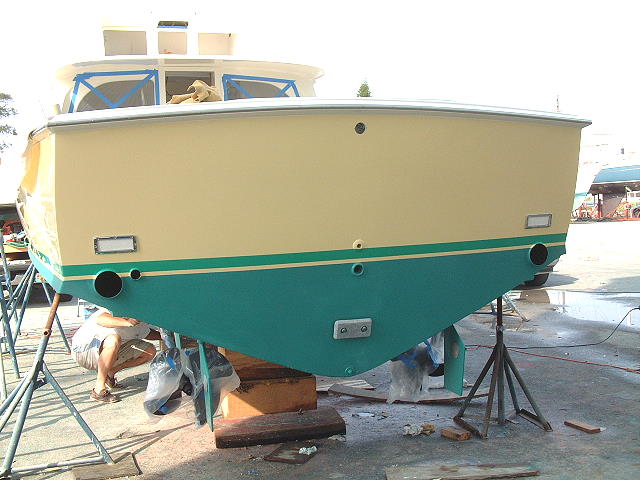Page 1 of 1
Anode
Posted: Apr 22nd, '14, 13:54
by JimmyG
I had a surveyor come out and check my boat for insurance he said installing dyna plates were not as important as a large sink anode (Divers dream), should I use both? Another question do these large anodes just get bolted to the transom with bolts (stainless, brass or bronze?) and hooked up to boats bonding strap?
Re: Anode
Posted: Apr 22nd, '14, 14:24
by CaptPatrick
Jimmy,
Those "large sinc anodes" are Zincs... They do a different service than the sintered bronze dyna plates.
The dyna plates are grounding things like radios, zincs are for galvanic corrosion control. One large rectangular zinc is what I've always installed on the transom.
Get two 5/8" bronze flat washers and solder a couple of feet of copper bonding strip on to each of the washers. Mount two bronze full thread 5/8" hex head bolts through the bronze washers and through the transom from the inside. lock 'em down with nuts and flat washers. The large zinc then gets bolted on to the two studs...
Tie in the two copper strips to the bonding system.

Re: Anode
Posted: Apr 23rd, '14, 01:47
by Pete Fallon
JimmyG,
The large sinc(Zinc) anodes. he should have clarified himself are the zincs , the 6"x 9'' or larger zinc transom mounted anode should be tied into you bonding system. The 31 has one of the better bonding systems if it is still intact, make sure you use a#8 AWG green wire or flat copper strip to attach from the main bonding strap to the transom zinc. If you keep the boat in a marina it is almost a necessary item to have , because of all the stray current corrosion that happens in a marina from bad marina wiring or other boats with bad bonding/grounding systems.
I just surveyed a boat that had a large transom zinc thru bolted to the transom, the yard idiots put the zinc on backwards, then painted over the shaft zincs, the trim tab zincs and never hooked the bonding wire back on when they changed out the zinc last October. When I got on the boat the thru hull fittings were turning orange because the bonding zinc wasn't attached, they had a bad check valve in the midship bilge pump and a wire from the auto switch that was broken off and submerged in the bilge water amid ship that couldn't be pumped overboard, when the boat sat at the dock. This was creating a perfect battery between the salt water the 12 volt power going into the bilge and a freely eroding thru hull fittings. I checked the condition of the sea cocks to make sure they were not eaten away, they were still okay, just discolored from the battery that was being set up by the broken 12v wire. They fixed the check valve and the broken 12 v olt wire on the auto switch, but the next repair was a shameful endeavor. They cut the old lugs off the bonding wires, left them on the sea cock studs, then charged the old owner for 100' of #8 AWG green wire and used 8 hose clamps to attach the bonding wires to the sea cock fittings, by the time they were done the charge was over a $1000.00. My corrosion meter read 320mv before their half assed repair, which means that the bronze sea cock fittings and everything else in the boat that was in contact with the sea water was freely eroding, after the repair they did it was over 950 mv which was over protected which is almost as bad as being under protected. When the boat got to Stuart, the clamps were all loosened up and the green wires were in the bilge near each fitting. I redid the ends of the bonding wires with new proper sized heat shrink lugs and attached the wires to the built-in studs on the sea cocks. It was about an hours work to remove the old lugs from the studs, cable tie the wires in place. The readings went down to 700mv which is proper protection for bronze fittings. My cost was about $15.00 for the lugs and an 2 hours of labor, far less than they charged the former owner.
Bonding systems when done right are the best protection against stray current corrosion for all your underwater gear. A bad system can sink your boat in a short time.
